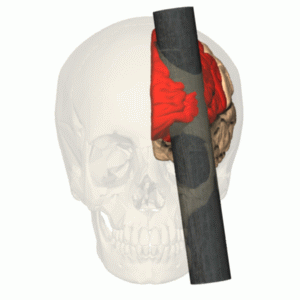When an accidental explosion sent an iron rod straight through the head of railroad construction foreman Phineas P. Gage, nobody could have expected he would survive. Nor could they have anticipated that it would prove to be a pivotal moment in medical history, giving rise to one of the most contentious therapies in medical history.
The iron rod that skewered Gage’s skull first pierced his left cheek, then traveled through his brain, and finally exited out of the top of his skull, eventually landing several feet from where the explosion took place “smeared with blood and brain.” It occurred on September 13, 1848 (which was a Wednesday, before you get any Friday the 13th ideas) when Gage was packing explosive powder into a hole using a tamping iron.
When the tamping iron made contact with a rock, it ignited a premature explosion, sending 13.25 pounds of iron rod – measuring 1 meter (3.58 feet) in length and 3.2 centimeters (1.25 inches) in diameter – hurtling through his head. Miraculously, he survived. In what might be considered suspiciously good humor, Smithsonian reports that Gage’s first words to Dr John Harlow – the doctor on scene – were: “Here is business enough for you.”
If surviving such a catastrophic incident weren’t notable enough, the biggest twist in Gage’s grisly tale is actually what Harlow observed over the course of his recovery. Following his injury, Gage’s colleagues and friends noticed marked changes in his personality and behavior, shining a light on a relationship between the mind and brain that had never been appreciated before. In a 1998 BMJ paper, neuroscientists Kieran O’Driscoll and John Paul Leach explore the ways in which Harlow noted he was “no longer Gage” following the incident.

The proposed route the rod took through Gage’s brain.
Harlow reported that Gage’s colleagues, “who regarded him as the most efficient and capable foreman […] considered the change in his mind so marked that they could not give him his place again […] He is fitful, irreverent, indulging at times in the grossest profanity (which was not previously his custom), manifesting but little deference for his fellows, impatient of restraint or advice when it conflicts with his desires […] A child in his intellectual capacity and manifestations, he has the animal passions of a strong man […] His mind was radically changed, so decidedly that his friends and acquaintances said he was ‘no longer Gage.’”
What they were witnessing was the manifestation of damage to Gage’s orbitofrontal cortex in the frontal lobe – an injury that would later be wielded in the form of a highly controversial procedure known as the frontal lobotomy.
By the mid-1900s, tens of thousands of lobotomies were being performed worldwide using techniques ranging from injecting alcohol directly into the brain to hammering an ice pick into the eye socket. The procedure aimed to cut off connections to the frontal lobe of the brain, with the goal of treating symptoms of mental illness – or just making patients easier to manage.
It’s surely a leap to imagine that Gage could have imagined that a rail rod through the brain would give rise to an entire branch of neurological intervention. Then again, it’s equally hard to comprehend that Gage lived to tell his tale at all.
Source Link: How The Skewered Brain Of Phineas Gage Changed Medical Science Forever